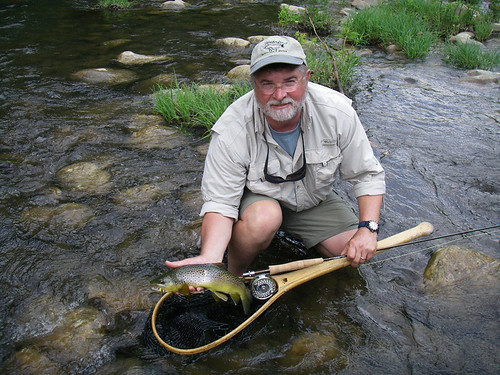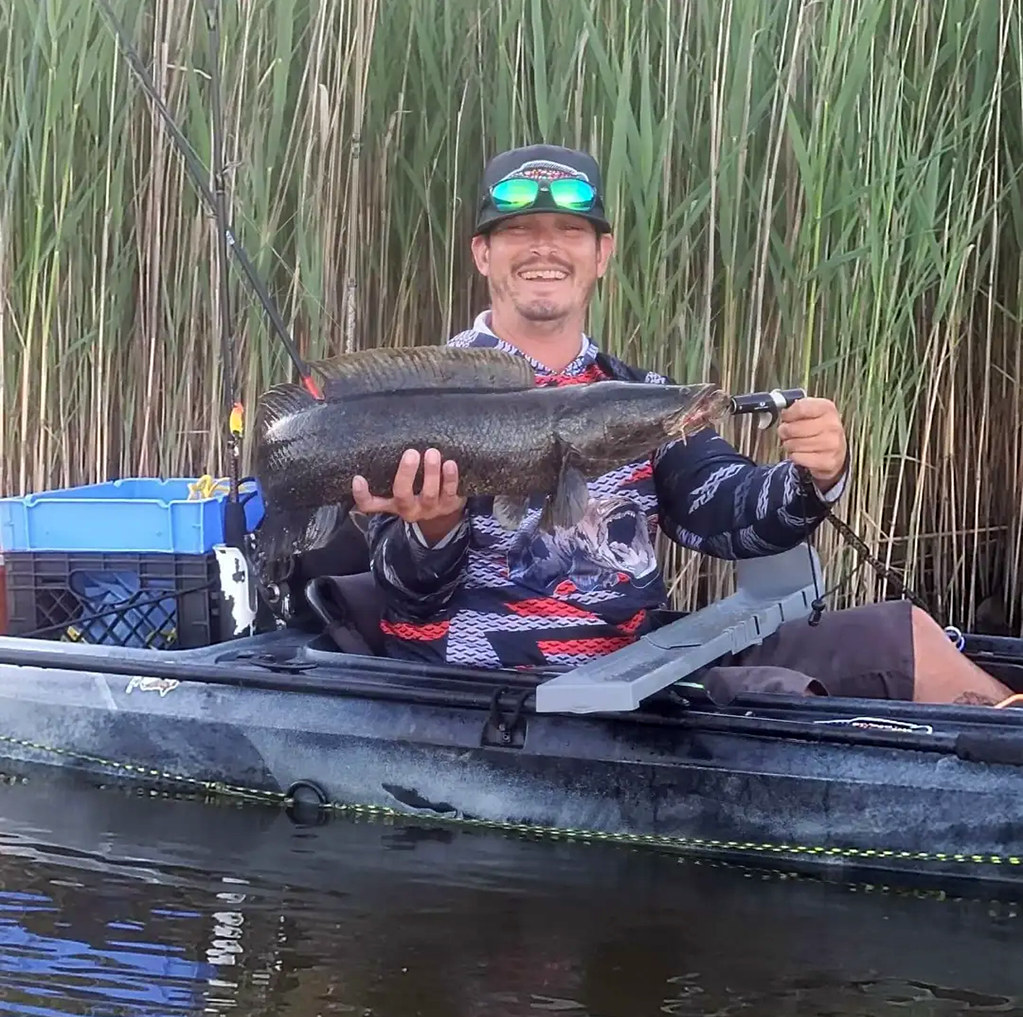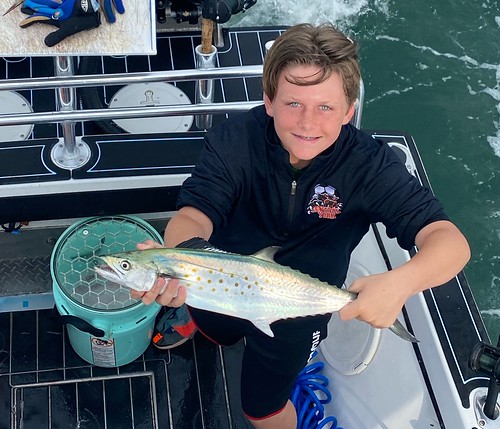Maryland Fishing Report – June 15

Photo by Alan Klotz
We often hear that we should take more time outdoors with family and friends, and fishing is a great way to do that. A dedicated angler never feels they are fishing enough – time is short so grasp every opportunity you can.
A fun family event next week can help us reduce the numbers of invasive snakeheads. The Maryland Department of Natural Resources is teaming up with the U.S. Fish and Wildlife Service to host its second annual snakehead derby at Gunpowder Falls State Park in Baltimore County. Snakes on the Dundee II will take place June 25 at Dundee Creek Marina.
Hot summer weather creates tough conditions for striped bass survival, which is why DNR once again will run its striped bass fishing advisory forecast for the warmest months, so anglers can better plan their fishing for striped bass to lessen mortalities.
Forecast Summary: June 15 – June 21:
It’s another great week for exploring Maryland’s tidal waters with sunny, warm weather and moderate wind conditions. Chesapeake Bay surface water temperatures are holding in the mid to upper 70s and will likely continue to rise all week. If you are seeking the warmest waters, fish the surface later in the day as well as downwind areas. If you are seeking areas with cooler waters, fish the surface early in the day, and deeper waters or upwind areas later. Maryland rivers are currently running in the mid to upper 70s.
In most Bay areas there is plenty of oxygen for Bay fish from the surface to about 40 feet deep. However, in the mainstem from the Choptank River up to the Bay Bridge, adequate oxygen can be found down to about 20 feet to 30 feet.
Expect average flows for most Maryland rivers and streams all week. There will be above average tidal currents through Sunday as a result of the June 14 full moon.
There will be average water clarity for most of the main Bay as well as many rivers and streams. Expect reduced water clarity from algal blooms in the Back and Patapsco Rivers.
To see the latest water clarity conditions, check Eyes on the Bay Satellite Maps on the Maryland Department of Natural Resources website.
As always, best fishing areas could be further refined by intersecting them with underwater points, hard bottom, drop-offs, and large schools of baitfish.
For more detailed and up-to-date fishing conditions in your area of the Bay, be sure to check out Eyes on the Bay’s Click Before You Cast.
Anglers looking for striped bass action at the Conowingo Dam pool and the Susquehanna Flats edges continue to find slim prospects, despite concerted efforts of casting a variety of lures during the morning and evening hours. There is no shortage of large blue catfish in the lower Susquehanna River and surrounding areas in the upper Bay. In the dam pool there are flathead catfish and those casting lures are catching snakeheads now and then.
Cut bait works best for the flatheads and blue catfish, and white paddletails are a popular snakehead lure. Snakeheads are also being found in all of the tidal rivers in the upper Bay. Blue catfish are being found in most of the region’s tidal rivers – the Chester River holds a very large population, and the fish tend to be moving upriver to the Crumpton area and beyond. Channel catfish can also be encountered in the uppermost sections of the Bay and all of the region’s tidal rivers.
Elsewhere in the upper Bay, striped bass fortunes increase dramatically. The area from Pooles Island to Rock Hall offers some of the best striped bass fishing opportunities this week. Anglers are finding striped bass holding on many of the lumps southeast of Pooles Island – areas with names like Coal and Tolchester lumps, and the unnamed lumps between the Tolchester Channel and Pooles Island. Most successful anglers are using their depth finders to locate concentrations of fish and then live-lining spot. Anglers targeting striped bass are reminded that they must use non-offset circle hooks when live-lining or using any kind of bait. Using circle hooks helps prevent deep hooking when striped bass swallow a bait, which helps improve the survival rate of undersized fish. All efforts should be taken to release striped bass in the water now that air and water temperatures are rising to potentially unsafe levels. Visit the DNR website for responsible catch-and-release procedures and for tips on using circle hooks.

Jay Patterson holds a beautiful upper Bay striped bass. Photo by Travis Long
The Francis Scott Key Bridge piers and the mouth of the Patapsco and Magothy rivers are locations that have proved to be good places for live-lining spot this week. Spot can readily be found off the shore of Sandy Point State Park, near the Podickory Point Marina, and at the mouth of the Magothy in about 15 feet of water. Pieces of bloodworm on a simple bottom rig work the best.
Jigging can be effective with soft plastic jigs and the Love Point rocks is an excellent destination. Anglers are also chumming with good success and the added bonus of blue and channel catfish. Trolling medium-sized bucktails dressed with sassy shads behind umbrella rigs and small Drone spoons are another option. Casting poppers and paddletails is a fun option in the shallower waters near the mouths of the region’s tidal river during the morning and evening hours.
Fishing for white perch offers a fun activity in the region’s tidal rivers and the shallower ends of the Key Bridge and Bay Bridge. They are also a good target to extend a day on the water after catching your striped bass limit, which can occur rather quickly at times. Fishing with pieces of bloodworm on a simple bottom rig works wonders but using two dropped flies over a sinker or one dropped fly over a jig also works well. Anglers must keep in mind that no more than two separate hooks, flies, or jigs are allowed on any fishing rig.
The Bay Bridge piers are drawing a lot of attention from anglers who are drifting live spot back towards the pier bases. A few anglers are also using small white perch for live-lining. Others are doing the same with soft crab or cut baits with good success. Spot and white perch make good fresh cut bait, as does menhaden. All anglers are reminded that they must use non-offset circle hooks when targeting striped bass with any kind of bait.
Anglers are also having good luck catching striped bass at the Bay Bridge piers by casting soft plastic jigs near the pier bases in the morning and evening hours, during a good running tide. Skirted jigs remain popular and a little menhaden scent paste can also help your odds. If you’re not bouncing your jig off the concrete at times, you’re not getting close enough. The eastern side of the bridge is reported to offer the best opportunities.
Since the striped bass seem to be scattered in the middle Bay, trolling is a good way to cover a lot of water. A mix of bucktails dressed with sassy shads pulled behind umbrella rigs and single Drone spoons behind inline weights are good choices. The edges of the shipping channel and lesser channels leading out of the region’s tidal rivers, usually along the 30-foot edge, are good places to look for striped bass this week.
There has been some success for those live-lining spot along the 30-foot to 35-foot channel edges, when fish can be spotted on depth finders. Spot are readily available in about 15 feet of water off Chesapeake Beach, in Whitehall Bay, and behind Tilghman Island. Anglers are reporting a high percentage of sub-legal striped bass being encountered throughout the middle Bay.

Photo by John Cantrell
Blue catfish along with channel catfish are being found in the region’s tidal rivers. The Choptank River in particular has a substantial population that is continuing to expand. It is common to catch blue catfish weighing 10 to 20 pounds along the channel edges below Denton. Anglers fishing for largemouth bass are finding snakeheads near grass and spatterdock in the upper reaches of the region’s tidal rivers.
White perch are entertaining anglers of all ages this week. They can be found holding near docks and piers and offer a great opportunity for our youngest anglers. One only needs to bait up a hook with grass shrimp or pieces of bloodworm and drop it straight down. More experienced anglers can have a lot of fun casting small roadrunner or beetle spin type lures with ultra-light tackle near shoreline structure in the morning and evening hours.
If you’re looking for striped bass it is pretty hard to top the action in the lower Potomac River right now. The steep channel edge between St. Georges Island and Piney Point is the place to be. Many are trolling umbrella rigs behind heavy inline weights with bucktails dressed with sassy shads as trailers. The striped bass are suspended at about 35 feet along the channel edge. The channel edge is also a great place for live-lining spot.
Anglers are reporting a high percentage of sub-legal striped bass being caught this week, whether they are trolling, jigging, or casting along the shorelines. Anglers are urged to practice responsible catch and release methods when releasing undersized fish and to always use non-offset circle hooks when fishing for striped bass with bait.
The lower Patuxent River is another great place to look for striped bass by trolling with umbrella rigs, jigging, or live-lining spot along the channel edges. Anglers are also enjoying some striped bass action along the edges of the shipping channel by trolling along the 35-foot edge. Cove Point, the HS Buoy, and other steep edges are good places to look.

Photo by Eric Packard
Spot can be readily found in the lower and middle sections of the Patuxent River this week as well as in Cornfield Harbor, Tangier Sound, and near the mouth of the Honga River. Most are suitable for live-lining, and it will take a couple of months for them to achieve pan frying size. White perch are holding in the many tidal rivers and creeks of the lower Bay and can be caught on pieces of bloodworm, peeler crab, and grass shrimp, or by casting small plastic jigs, spinnerbaits, roadrunner type lures, and spinners along the shorelines of the rivers and creeks.
Cobia season is now open and these fish have been in our waters for a couple of weeks. Anglers will be anchored up and tending chum slicks and fishing cut baits, live spot or live eels in the back of their chum slicks. Cownose rays will be a significant problem but hopefully some cobia will be caught. The daily limit is two cobia per boat if two or more anglers are aboard, or one per person per day. Minimum length for cobia is 40 inches.
Large red drum are being caught and released In Tangier Sound, the Middle Grounds, and the Target Ship areas this week. Trolling large spoons behind inline weights is a popular way to fish for them, along with jigging or fishing with soft crab baits when schools can be spotted on depth finders.
Casting paddletails and poppers along the shorelines of the Bay and tidal rivers is a good and fun way to fish with light tackle during the morning and evening hours. Speckled trout are mixing in with striped bass on the eastern side of the Bay along marsh edges and tidal creeks. Drifting soft crab baits on an ebbing tide is a fun and productive way to fish for speckled trout and red drum in the marsh creeks of the Eastern Shore.
Fishing for blue catfish in the tidal Potomac, Patuxent, and Nanticoke rivers is as good as it ever gets. Fresh cut bait of menhaden, gizzard shad, white perch, or bluegills will certainly draw their attention, and setting up a chum slick will have them lined up behind your boat. There are also many shoreline spots to fish for blue catfish and a forked stick to hold your rod. A comfortable chair and some snacks and drinks round out the experience.
Northern snakeheads are providing a lot of fishing action in the backwaters of Dorchester County and in the tidal Potomac, Patuxent, Nanticoke, and Wicomico rivers. They seem to be moving around a lot – perhaps they are looking for a mate or that perfect spawning area. They are aggressively attacking white paddletails or buzzbaits and frogs over grass.
Recreational crabbing is starting to pick up a little speed, and crab fortunes are becoming more bountiful this week. Crabbers are able to catch up to a full bushel per outing, although ore commonly about a half-bushel in the lower Bay. As is typical this time of the year, some of the better catches are coming from the Eastern Shore tidal rivers, with the western shore a close second. In the middle Bay catches range from a few dozen crabs to a half bushel per outing.
Crabbers reported a lot of recently shed large crabs a week or so ago and now those crabs are filling out to become a nice heavy crab measuring 6 inches or better. Due to the high price of razor clams, many are using chicken necks on trotlines and some are having good luck with menhaden baits in their collapsible crab traps.
Anglers in the western and central regions of the state are enjoying catch-and-release action in the fly-fishing-only trout management waters. There are a number of hatches in progress so casting dry flies is often considered by fly-fishing anglers the ultimate way to fish for trout. Terrestrial insects are also on the trout’s menu so hoppers and ants also make good choices.
The streams and rivers of Western Maryland offer a great way to beat the summer heat whether wading in a cool flowing trout stream or kayaking down a lazy river. The Monocacy, Conococheague, and the North Branch of the Potomac River are areas worth exploring for kayaking.
Although fishing is good for a variety of species at Deep Creek Lake, anglers are reporting that the vacation season is in full swing. It is best to get off the water by mid-morning unless you’re okay with dodging boat traffic and jet skis. There can be refuge to be found in back coves. Floating docks are excellent places to look for largemouth and smallmouth bass, and flipping wacky rigged worms and stick worms under the docks is a great way to entice a lounging fish to pick up a bait. A mix of yellow perch, walleye, and smallmouth bass can be found along deep grass edges by drifting minnows.
This is an excellent time of the year to fish for largemouth bass; they are slipping into a summer mode of behavior but water temperatures are still a bit forgiving, so good fishing can last until late morning and begin again during the late afternoon and evening hours. Targeting the shallow waters and grass in the mornings with a variety of topwater baits and transition areas with spinnerbaits, jerkbaits, and lipless crankbaits are good tactics. In tidal waters, an ebbing tide is a great time to look for largemouth bass on the outside edges of grass and spatterdock.
Bluegills and a variety of sunfish species always provide plenty of fun for the light-tackle angler with spin or fly fishing gear. They can be found in almost every body of water in Maryland. They also provide a great target for our youngest anglers and are often the first fish they encounter.
Surf fishing is beginning to move to a typical summer mix of kingfish, croaker, and spot on pieces of bloodworms on bottom rigs. Blowfish and flounder are being caught on squid baits and small bluefish on finger mullet or cut spot. Cownose rays, sandbar, blacktip, and sand tiger sharks are on the prowl for larger baits of cut menhaden or spot.

Photo by Scott Lenox
At the inlet and Route 50 Bridge areas, a mix of bluefish and sub-legal striped bass are entertaining anglers drifting cut baits or casting soft plastic jigs and bucktails. Flounder are dominating the fishing scene in the back bay channels, and as long as the waters remain clear, fishing is very good.
Outside the inlet and close to the beaches, trolling small Clark and Drone spoons is a wonderful way to catch the Spanish mackerel and bluefish that have moved into the region. Farther out at the offshore wreck and reef sites, anglers are catching sea bass and a few large flounder. Even farther offshore at the canyons, a mix of yellowfin tuna and dolphin are providing good fishing for those trolling. Anglers deep dropping are catching a mix of blueline and golden tilefish. The first white marlin of the season was caught last week and one lucky angler brought a swordfish to the docks this week.
“Three-fourths of the Earth is water and one-fourth is land. It is quite clear that one is intended to spend triple the amount of time fishing as taking care of the lawn.” – Chuck Clark
Maryland Fishing Report is written and compiled by Keith Lockwood, fisheries biologist with the Maryland Department of Natural Resources.
Click Before You Cast is written by Tidewater Ecosystem Assessment Director Tom Parham.
This report is now available on your Amazon Echo device — just ask Alexa to “open Maryland Fishing Report.”

 1-888-373-7888
1-888-373-7888 233733
233733